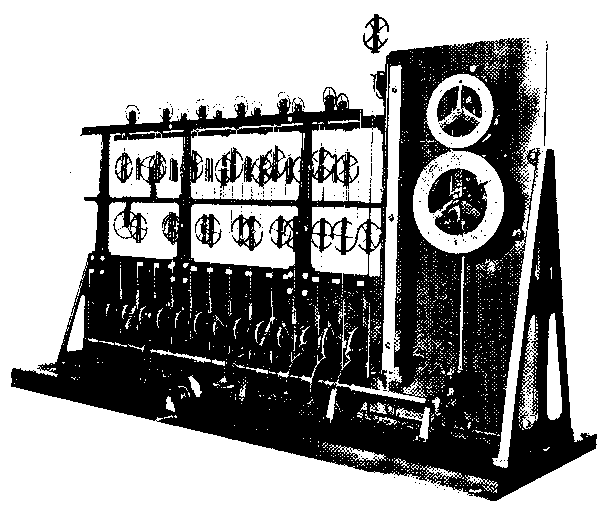
Afranio Rubens de Mesquita
OCEANOGRAPHY INSTITUTE OF THE UNIVERSITY OF SÃO PAULO
JULY 2000
CONTENTS
ABSTRACT
1 - INTRODUCTION
2- SEA LEVEL
3- HOURLY/DAILY SEA LEVEL
4 - SEASONAL SEA LEVEL
5 - LONG TERM SEA LEVEL VARIATION
6 -LONG TERM SEA LEVEL VARIATIONS DUE TO GLOBAL WARMING.
7 - TRANSFERENCE OF MEAN AND EXTREME SEA LEVEL VALUES
8 - ACKNOWLEDGEMENTS
9 - REFERENCES
ABSTRACT
The sea level of the Brazilian coast has been measured since 1781, at that time, for the little known phenomenon of tides and now, for it turned into a worrying subject, due to Global Changes of the present days, that may cause it a great deal of changes in a short period of time.
This work describes the main characteristics of the non tidal variability of the hourly sea level, the daily sea level, the seasonal sea level, of the long term sea level along the Brazilian coast and describes results of a transference method of sea level and its extremes for inaccessible and not far apart sites.
The hourly variability of the sea level due to the variability of the wind force and direction accompanied by the variation of atmospheric pressure related to the passages of the cold fronts may reach 2 meters and the daily values about 70 cm above mean sea level in the borders cities of the south-eastern coast.
The seasonal sea level variability is smaller in the southernmost ports as Imbituba (10cm) and greater in Belem (20 cm). Belem has two sea level seasonal peaks, one in March/April and other in September/October probably due to the Amazon river flow annual variability. They show peaks in February for ports situated in the East coast caused by intense solar radiation and precipitation and a maximum level in May, caused probably in the south-eastern region by the esteric effect due to the occurrence of a greater volume of warmer sea water of the Brazil Current that remain until August-September. In August-September-October occur the lowest levels of the seasonal sea level that after a small increase in November fall again during the months of December and January due to a greater volume of colder Sub-Tropical waters. This alternate predominance of water masses in the area gives rise to the phenomenon of "seasonal thermal inversion" that may eventually occur also in the entire east Brazilian coast
The spectra of seasonal sea level values in south-eastern have spectral bands, determined with 95% confidence intervals, with peaks around 22, 13, 3.3, and 2.1 years that are supposed to be related to the El Niño/Southern oscillation of the Pacific (ENSO) and ultimately related to the variability of the solar spots and atmospheric precipitation in the north-east part of the country.
With the same statistical interval were also determined bands related to the 14 and 16 months periodicities of the "tide pole" the 12 months band (the annual tides, that is as strong as the 13 to 22 years north-east draught bands) and the 5 months band of the planetary waves.
The long term sea level of the relative mean sea level indicate that in the Brazilian coast it is increasing at a rate of 4 mm/year or about 50 cm/ century. The most probable of its causes is the now days the extra global warming gases produced and emitted to the atmosphere.
The transference of the sea level and the extreme values to places of difficult access can be made via a statistical method . Its checking with data from Cananeia and Ubatuba, ports of the south-eastern region, produced a maximum error in the monthly sea level of the order of 7 cm and of the order of 1 cm for the mean sea level and gave an interval of uncertainty of 10 cm for the extremes, that for many practical aspects may be useful estimates.
1-INTRODUCTION
Measurements of Brazilian sea levels for tides were firstly taken in Rio de Janeiro , 1781, by Sanches Dorta, in the Bahia da Guanabara, near to its entrance, ( Belfort Vieira, 1942) approximately 100 years after Newton had published his Principia Mathematica that revolutionised the cosmology and dynamics of the Sea and Earth's tides are directly related to ; also about 100 years after the astronomer Sir Robert Moray in England had made his plea for accurate measurements of sea level by means of tide gauges, aided with measurements of currents and meteorology; and also nearly 80 years after Cassini, from France, had made attempts of predicting sea level of tides from previously taken tide records of Brest, France, Cartwright, (1999).
First measurements for fixing the datum for the mean sea level of the harbour of Rio de Janeiro were taken in 1831 as a series of one year length. The record is kept presently in the Museum of the "Diretoria de Hidrografia e Navegação" of the Brazilian Navy. Other measurements for tidal sea level keeping started to be taken by Federal organisms as " Instituto Nacional de Pesquisas Hidroviárias" of the Ministry of Transport, since 1905 in various ports along the Brazilian coast, starting in different years, from the port of Belém in the extreme North to the port of Rio Grande in the extreme South of the coast and are now days poorly kept in the archives of that Institute.
It was only after the participation in the International Geophysical Year in 1958 that measuring the sea level acquired locally a sort of scientific flavour that moved researchers of the Institute of Oceanography of the University of São Paulo. Permanent tide gauges (registering instruments of the sea level Measurements via a buoy and a clock machinery) of the cities of Ubatuba and Cananeia were installed in the years 1967 and 1954 respectively. From these measurements emerged the first contributions on the sea level of the estuarine region of Cananeia, Miniussi (1958) and on the relationship of the sea level with the meteorological and sea water variables, Johanessen, Miranda and Miniussi, (1967) of Cananeia, following Sir Robert Moray´s plea of 1666.
Harmonic studies of sea level for tides started in the beginning of the century in the "Observatorio Nacional do Rio de Janeiro" followed by tidal predictions performed with a Kelvin "tidal predictor" machine, Fig 1. Alix Lemos (1928).

The work of doing these analyses and predictions were passed to the "Diretoria de Hidrografia e Navegação" in 1964 (DHN, 1996), after the developments in the analysis there (Franco, 1968). Tidal constituents were determined from the measurements (periodical components of tides whose amplitudes and phases can be put into correspondence to the periodical motions of the Sun and Moon relative to a reference system fixed on the Earth) for the city of Cananeia (Franco & Rock 1972).
In attention to an increasing interest of the community to the different aspects of the sea level along the Brazilian coast, Mesquita & Harari (1983) produced the first report on tides and the tide gauges of Cananeia and Ubatuba, closing, at the IOUSP, what can be called the local first period, of the scientific knowledge of the phenomenon of tides in the south-eastern coast and perhaps in the entire coast of Brazil, which commenced in the beginning of this century.
Concomitantly , Emilson (1961), (Physical Oceanography) firstly described the water masses of the south eastern part of the coast , Miranda (1970) produced the first calculation of the geostrophic currents of the same region, Magliocca et al (1979) firstly described the oxygen and nutrients distribution (Chemical Oceanography), Teixeira, (1973) described for the first time the primary production of the waters and more recently Aidar Aragão (1980) ( Biological Oceanography).
The seasonal variations of the Coastal Water were analysed by Mesquita (1969,1974) and led to the identification of the phenomenon of "seasonal thermal inversion" that is typical of the region, as the Tropical Water and the Subtropical Water alternatively occupy the area seasonally, producing in the layers below the thermocline, (region of the profile of temperature, near to the surface that suffers great vertical variation of the thermal values due to daily and seasonal variation of solar radiation) higher temperatures, during the winter months, and low temperatures, during the summer months. Fig. 2.
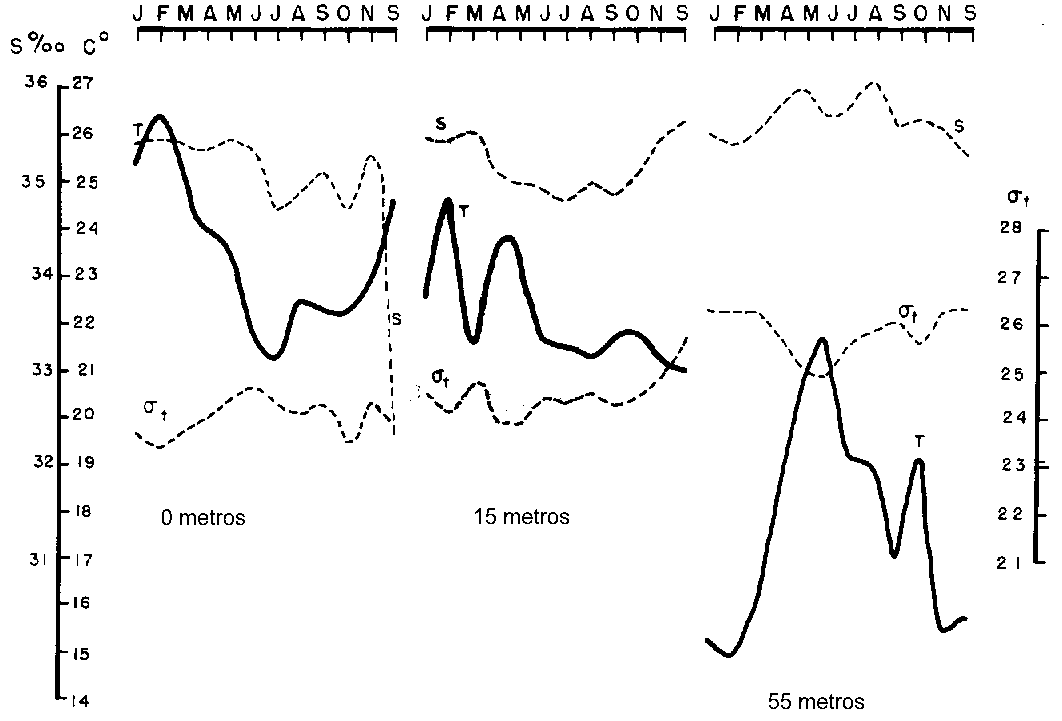
This alternation is more intense specially in the coastal region near to Cabo Frio (RJ), where it was discovered also the phenomenon of " Coastal Upwelling" , Silva (1968) (oceanographic phenomenon by which the waters of the bottom layers come to the sea surface fertilising the oceanic region where it occurs).
2 -THE SEA LEVEL
The sea level is amongst the measurements of the sea the one that syntetises the influences of various oceanic processes that include the effects due to marine currents, effects due to the field of mass , density, meteorological effects due to radiation, precipitation, evaporation, pressure, wind force and direction, effects due to the Earth's geopotential , the geoid ( surface that has the same value of the acceleration of gravity), effects relative to the oceanic boundaries, effects due to the rotation of the Earth, as well as the effects of the tidal forcing due to the astronomical nature of the tides.
The last effect corresponds to the response of the ocean to the "Tide Generating Potential", function written from the Universal Law of Gravitation of Newton, in terms of the rotation round common centre of masses and orbit parameters of the Earth, Sun and Moon, that allows the calculation of the gravitational and inertial forces that produce the Earth's and Oceanic tides.
3 - THE HOURLY/DAILY SEA LEVEL
The effects relative to the hourly variation of the meteorological parameters in the South eastern region may be seen in Fig 3, where it is shown the hourly sea level variation in Cananeia, during an occasion of a severe Storm Surge that covered the entire area. As can be seen in the days 25th of December of 19790 to the 5th of January of 1980, simultaneous measurements of wind force and direction were recorded that are shown in Fig 3 in their North - South and East - West components. The directions of the wind were made the same as those of the currents, i.e., to where the winds go and not to what is usual in meteorology, from where the winds come.
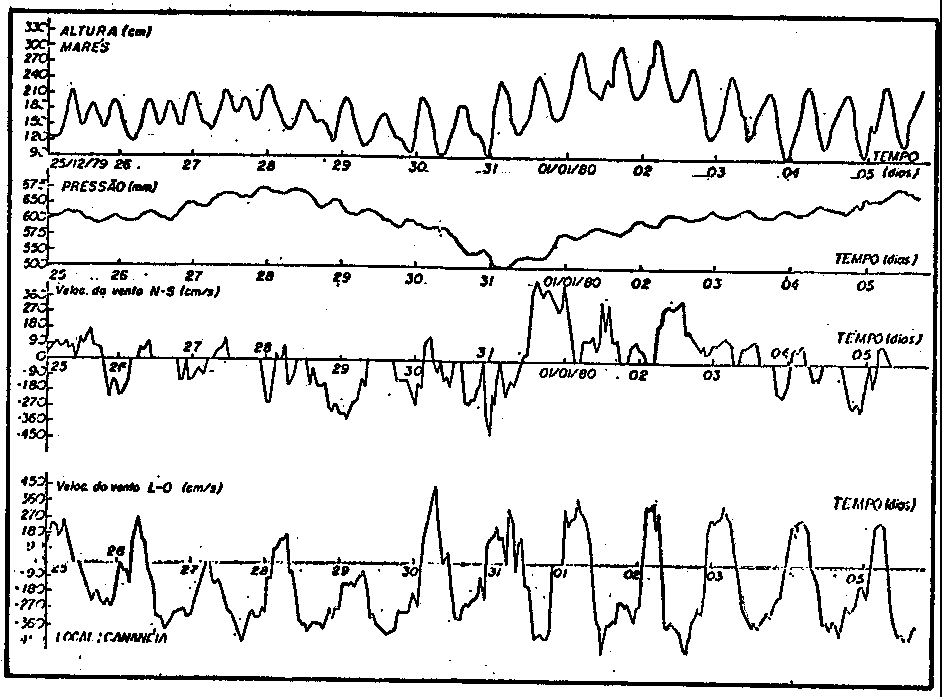
The fluctuation of direction and wind force, associated with a pronounced variation of atmospheric pressure due the passage of an atmospheric "cold front" , that occurred in an occasion of a sizygy ( the instant of the highest tide that occurs during Full and New Moon) produced a hourly variation of the tidal sea level of about 2 meters, and a daily variation of about 70 cm that caused a devastating effect, as the coastal cities of the entire South eastern area were invaded by the sea.
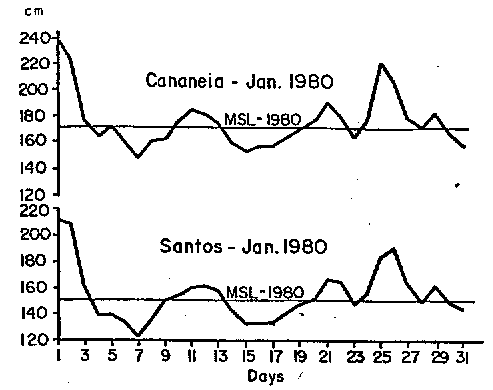
Figure 4 shows the mean daily sea level ( mean of the daily values of the sea recorded during the period of 24 hours) of the same time interval for the cities of Santos and Cananeia and Figure 5, the sea levels recorded in a different time interval of ports of Paranagua and Cananeia . As can be observed the curves indicate that the variation of the daily sea levels are highly correlated and are similar all along the South-eastern coast.
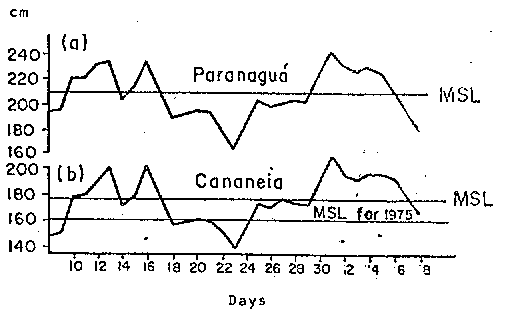
It may also be observed that pronounced deviation from the sea
level mean occur frequently in the South-eastern coast without producing
similar sea invasion of the coast, as occurred in 1st to 2d of January
of 1980. With predictions that values of long term sea level rise
that may reach 50 cm/century, however, even these minor variations of the
daily mean sea level may frequently produce the invasion of the cities
of the coast in not too far way years ahead.
4 - THE SEASONAL SEA LEVEL
First effort in the understanding the sea level seasonal variation (mean of the mean daily sea levels recorded in the period of one month during all months of the year) of the city of Cananeia is shown in Johanessen et al (1967) Fig 6 in which they describe the relation with the meteorological variables as solar radiation, atmospheric pressure, wind force and direction, atmospheric precipitation, air temperature and sea temperature.
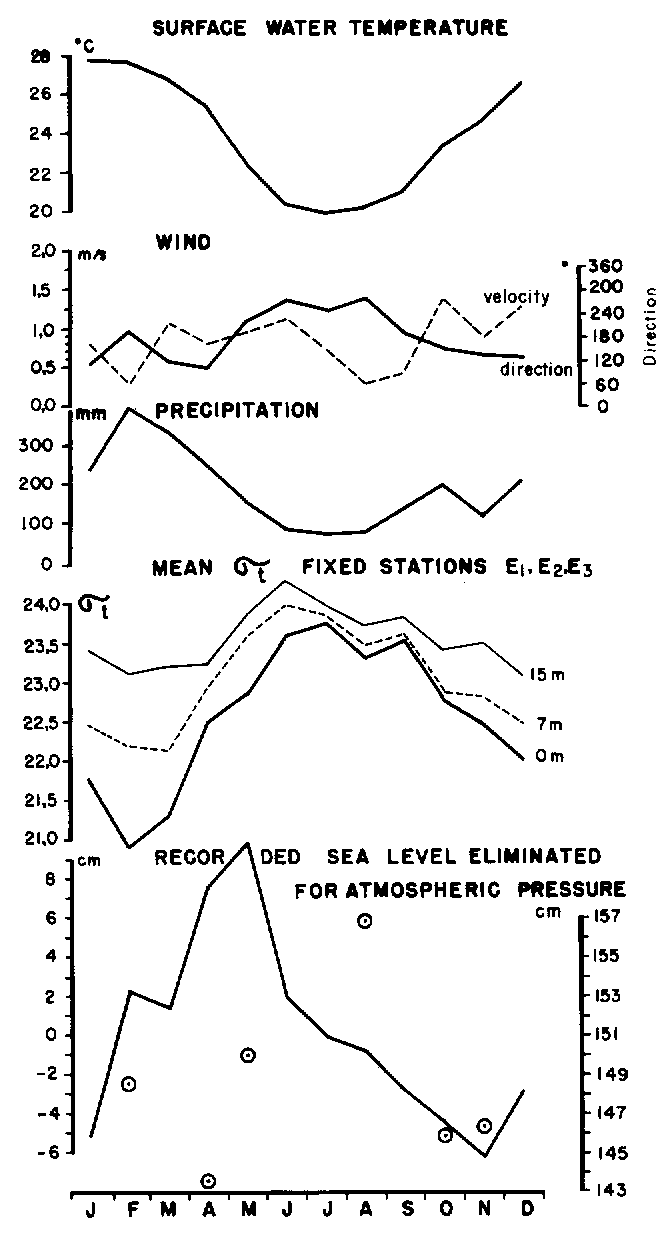
The amplitude of the seasonal variation in the South eastern region is about 15 cm with a secondary maxima in February caused by intense solar radiation and high atmospheric precipitation and maxima in May that is interpreted by Mesquita Harari and França (1995) as due to the esteric variation (variation of the sea water volume by effects due to temperature of the water making the increase of the sea level) , of the sea level caused by the occurrence in the South eastern region a greater volume of warm waters of the Brazil Current that predominates in the area until the months of August to September.
In September occur low values of the seasonal sea level, which after an increase in November, turn to decrease in the months of December till January in consequence of the dominance in the area of the colder Sub Tropical Water in the entire region. The alternation of warmer waters in the winter months and colder waters during the summer months gives rise in the region to the phenomenon of seasonal thermal inversion, Fig 7. ( Mesquita, 1969,1974,1994).
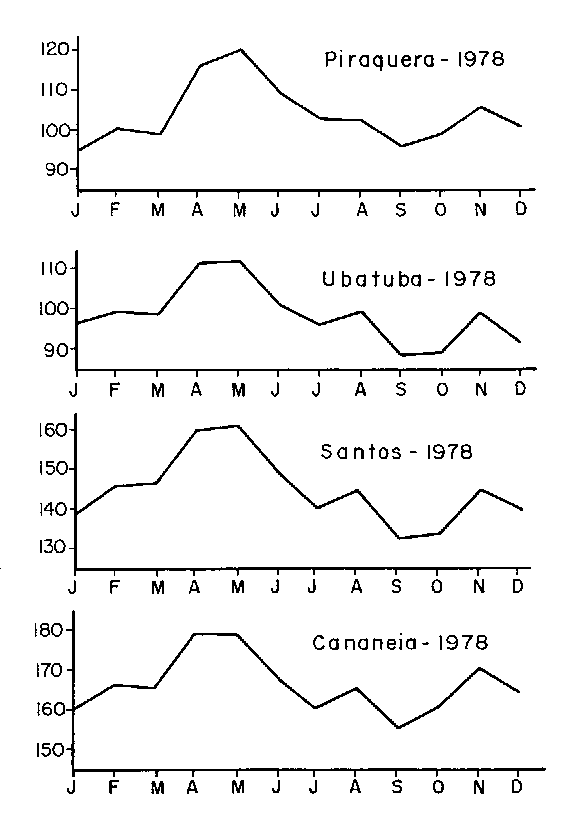
Similar variability of the seasonal sea level is exhibited in the ports of Piraquera, Ubatuba , Santos and Cananeia in the year 1978 as shown in Fig 7. Similar variability is shown in all the Brazilian coast for the ports of Imbituba, Salvador, Recife, but differently by the port of Belém as shown in Fig 8. Mesquita, Franco & Harari, (1987), from ten years Measurements taken by the USA´s Coastal and Geodetic Survey.
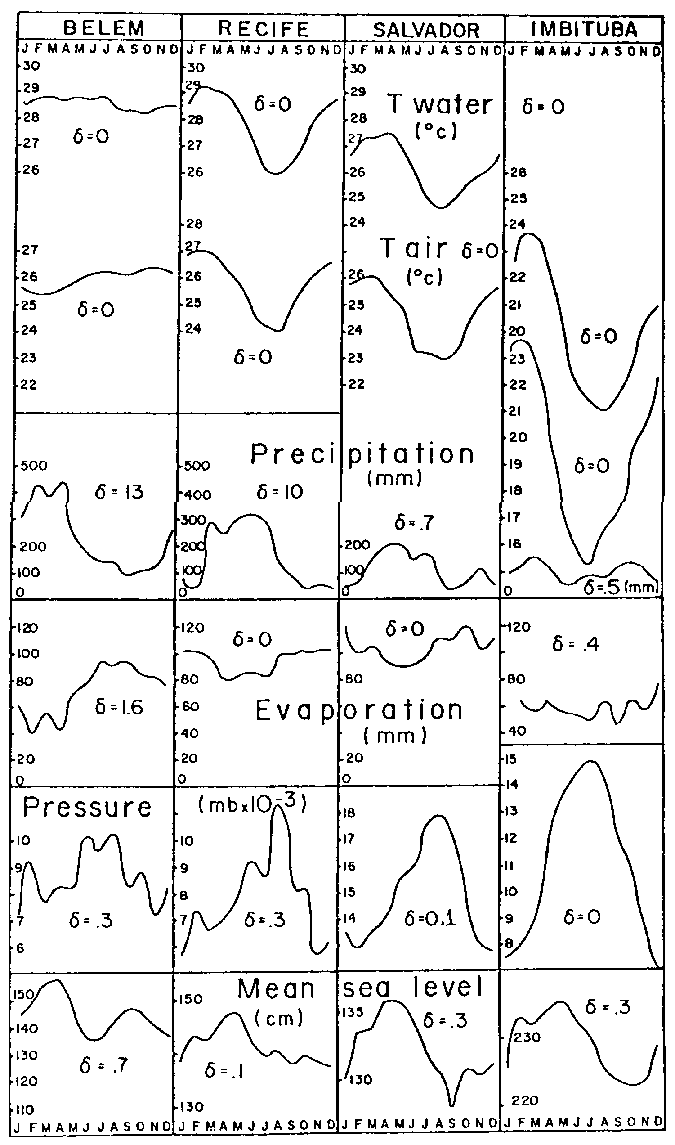
The monthly sea level of Belem has two peaks, one in March/April
and other September/October, that are probably due to the different regional
river flow regimes of the northern and southern tributaries of the Amazon
river. Ports of Recife, Salvador and Imbituba have similar variability
as the Cananeia´s shown in Figs 6 and 7 with a secondary peak in
February a maximum in April /May and lower values from August/September/October.
Seasonal ranges are greater in Belem (20 cm) and smaller in Imbituba
(10 cm).
5 - LONG TERM SEA LEVEL VARIATION
The long term sea level variation has also a trend of astronomical origin. As the seasonal variation, for example, they are also excited by precise deterministic astronomical variations. The seasons in the South eastern region are astronomically determined by orbit compositions of the motion of the Earth around the Sun that produce the Summer and Winter Solstices ( positions occupied by the Sun in the Southern hemisphere and in the Northern hemisphere during each year) exactly in the days of 21 December and 21 of June, respectively.
To these compositions, said to be deterministic, (the one one has almost absolute certainty) the South-eastern Shelf responds with maximum seasonal values of temperature of the sea water in Santos platform, with a turbulent delay of about one month later and with an uncertainty of its occurrence of one day, (Mesquita & Harari, 1977).
The recordings of this response, called random , or "turbulent", are defined as "stochastic process" or "non linear process", meaning in this case that the ocean of the south-eastern region responds "non linearly" to the deterministic astronomical action, fact which is also true all over the oceans.
The more one acts to determine with accuracy the thermal values of the sea water in the seasonal scale, bearing in mind the deterministic action that produce them, the more is impossible to predict them with the same exactness. The same is true for the occurrence of the monthly thermal values, due to the unavoidable uncertainty inherent to the "stochastic processes" temperature of the sea water in the South eastern region. That is also what happens to the seasonal values of the mean sea level.. They have their maximum (and minimum values) determined deterministically by the summer and winter solstices position of the Earth around the Sun, but they actually only happen about a month later in Jan-Feb, (Jul-Aug) in the region. This is not actually quite followed by south-eastern waters in Fig 7 due to the "turbulent", or nearly "random" influences on the mean sea level of the alternate occupation of the area by the Tropical and Sub Tropical waters as already pointed out.
Similar characteristic of uncertainty, one may admit, is attached to the interdecadal and decadal variations of the sea level recently identified in the region a by Mesquita, Harari and França, (1995,1996). Figure 9 shows the spectral distribution of the variabilities of the seasonal sea level of Cananeia. The spectral bands contain peaks determined with a 95% confidence intervals that are centred in peaks exhibiting periodicities of 22 years (amplitude, 11 cm), 13 years (11 cm), 3.3 years (10cm) and 2.1 years (10cm ), that are excited by the variability of the ocean-atmosphere stochastic processes called ENSO (El Niño and Southern Oscillation) which themselves may have also some delayed relation with the variability of solar spots, (Morettin et al. 1993).
The corresponding intervals of uncertainty can not yet be estimated, but by assuming similarity between the seasonal process scale and the decadal and Intradecadal processes scales and take a "turbulent" time delay proportional to one month of the seasonal process (1/12 = 0.083) to estimate them, one obtains: Y/22 =0.083, resulting Y = 1.8 years for the Enso 22 years band, and YY/13 = 0.083, giving YY = 1.08 7 years for the 13 years band delay and YYY/3.3 = 0.083, resulting YYY= 0.27 years for the 3.3 band delay and finally YYYY/2.1 = 0.083, giving YYYY= 0.17 years or 2 months delay for the 2.1 years band. Proceeding similarly for the "turbulent" uncertainty one may take 1/30 = 0.033 obtaining Z/22=.033 for the first band giving Z=.726 years and so on. These estimates are to be taken as examples of how "turbulent" similarity between scales may be used and interpreted as time delays and uncertainties not as final results.
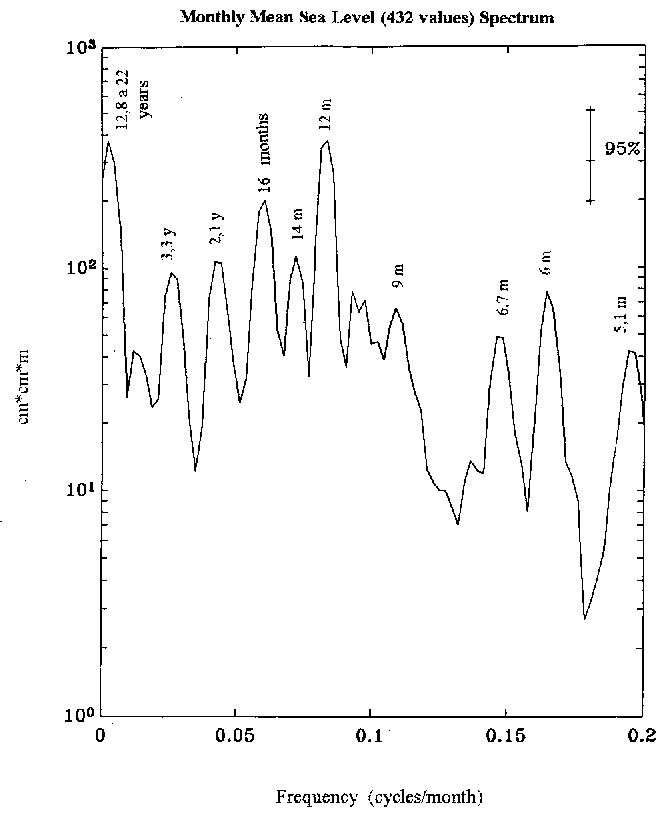
In the spectrum are also identified spectral bands related to the stochastic processes of the long term sea level values of the South eastern region, as those related to the Chandler Wobble (rotational motion of the Earth's polar axis) of about 14 (10cm) and 16 months,(11cm) the band of 5 months(5cm) that probably are related to the Planetary waves ( waves generated by the moving field of mass and the Earth's rotation) and the well known annual and semi-annual bands of the sea level.
Variabilities linked to the almost periodical astronomical forcing as the Earth's declivity (Inclination of the Earth's North-South axis relative to its orbital plane around the Sun , the ecliptic) ; the precession of the equinox ( position relative to the fixed stars of the days of the year , 21 of March and 23 of September, in which the nights and the days have equal duration ) due to the rotation of the ecliptic and the variation of the Earth's eccentricity ( indices that measures how much the elliptic orbit is different from a circular orbit) are the causes of the stochastic processes of the almost periodical oscillations of the increase of polar ice and consequent diminishing of the mean sea level called glaciations.
Most of present records of tides are nearly long enough to have some
influence of the precession of the equinox that can be identified by the
analysis of the tides. All the others glacial periodicities, however, can
only be recorded in long series, built from sediment cores (long sample
of sediments obtained with tubes that are forced into the bottom of the
ocean) from the oceans. Recorded series as long as 250.000 years have been
so far produced showing the almost periodical sea level variation during
the glacial periods, (Emery & Emery, 1980). Marks of the glaciation
in the south eastern region with the oceanographic evidences are shown
in Furtado et al (1996), and a summary of the variabilities, known as of
Milankovitch , are reviewed in Mesquita (1994,1998).
6 -LONG TERM SEA LEVEL VARIATIONS DUE TO "GLOBAL WARMING".
Long term sea level " Global Warming" variations have recently been recorded all over the world´s continental borders. They differ from the long term variability of the sea level associated with the glaciations, as they became apparent from the beginning of this century till now and are characterised by an increase of sea level rate, as compared to the ones recorded before, (one to two mm/year).
Bearing in mind the accepted world mean rate of sediment deposition in the bottom of the ocean, (1 to 3mm / year) one may be inclined to attribute rates of about 4 mm/year, as determined in the Brazilian coastal borders and from recent oceanic measurements of Altimetry, (distance of the satellite to the sea surface measured by the time delay between the emission and reception of a radar signal) of the Equatorial Atlantic, (França, 2000) as caused by extra global warming gases, (CO2, NH4, Water Vapour and others) expelled to the atmosphere as a result of the increasing human activity.
The rate of variation of the relative mean sea level has been recorded in the South-eastern region since 1954, through the calculation of the inclination of the curves representing the series plots of several ports of the area. The variability of the relative sea level of the area and others in Brazilian coast are shown in Fig 10. As can be seen, not only the South-eastern coast as all ports of the Brazilian coast are experiencing an increase of the relative sea level heights, (level of the sea obtained by tide gauges that are locked and fixed in the Earth's surface and it is impossible to determine if the ocean's volume is increasing, or if the land is sinking from these measurements only) of nearly 4 mm/year or about 50 cm / century.

Estimates of the global absolute sea level obtained via Altimetry, however, are yet not definite (Woodworth , 1997) and evidences from geological studies of the local coast, as in Martin et al. (1987), as well the estimates based on all the series of the world's ports from all continents including the poles , (Mesquita, 1994) and the evidences of Chao (1996) on the Milankovitch of present days measurements are arguments that apparently oppose those figures. There are also evidences that the Brazilian coast may be sinking, (Mesquita, 1998) making the question of what is the main cause of the rate of increase of the long term relative sea level due to global warming, locally, an yet rather controversial one.
To contribute the solution of the raised questions, is presently under way, in collaboration with the Polytechnic School and the Institute o Astronomy and Geophysics of this University, the obtainement of measurements of GPS (Global Positioning System), (measurements of positioning on the surface of Earth by satellite, of great accuracy) and absolute Gravimetry ( accurate absolute measurements of the acceleration of gravity) in the research Station João de Paiva Carvalho of Cananeia.
With these measurements one will be able to determine if the geoid,
where the sea level gauges are fixed, is changing (gravimetry) and the
vertical motion (GPS) of the terrain. These measurements are considered
absolute and may help to find out the accurate answer to the present
controversies due to the Global Warming ( heating of the Earth due
to the imprisonment of Solar energy by the extra amount of gases as CO2,
NH4 and others, produced by humanity in the latest 100 years approximately),
in the Brazilian coast.
7 - TRANSFERENCE OF MEAN AND EXTREME SEA LEVEL VALUES
The transference of the mean sea level from a place to another
is, for beach studies, a work often necessary and relatively straightforward,
by means of a levelling instrument, or a transparent tube filled with water,
when there are facilities available, or even possibilities for the work
. The transference of extreme values from any other place require, however,
much than that, it requires the means of statistics for the
job and a reasonably short set of sea level measurements.
.
The transference of mean sea level via statistics is, quite often possible
and can be made within reasonable statistical tolerance for most of the
practical aspects. This was shown to be the case for the data of the permanent
station of measuring the sea level of Cananeia and the canal of Varadouro.
A nearby, but inaccessible pier in the estuarine area near the port of
Paranagua, State of Panarná, where there were a series of sea level
measurement two and half months long. They were taken for the purpose of
dredging the Channel of Varadouro, that links the estuary of Cananeia to
the one of Paranaguá, for navigation purposes. There was the need
to know whereabouts was the mean sea level relative to the ground in the
Canal .
Initially, from simultaneous data of both places (Cananeia and Varadouro), the respective histograms were constructed so that to calculate the transfer function. (Mesquita & França, 1987). Fig. 11. By comparison of the histograms of 226 days of simultaneous data there was the estimation of the appropriate transfer function from one to the other histogram. Once this is done the transfer function so estimated was used for the transference of the corresponding histogram of one year data. From this histogram it was possible to estimate the extreme sea levels and the mean sea level of the Varadouro Channel.
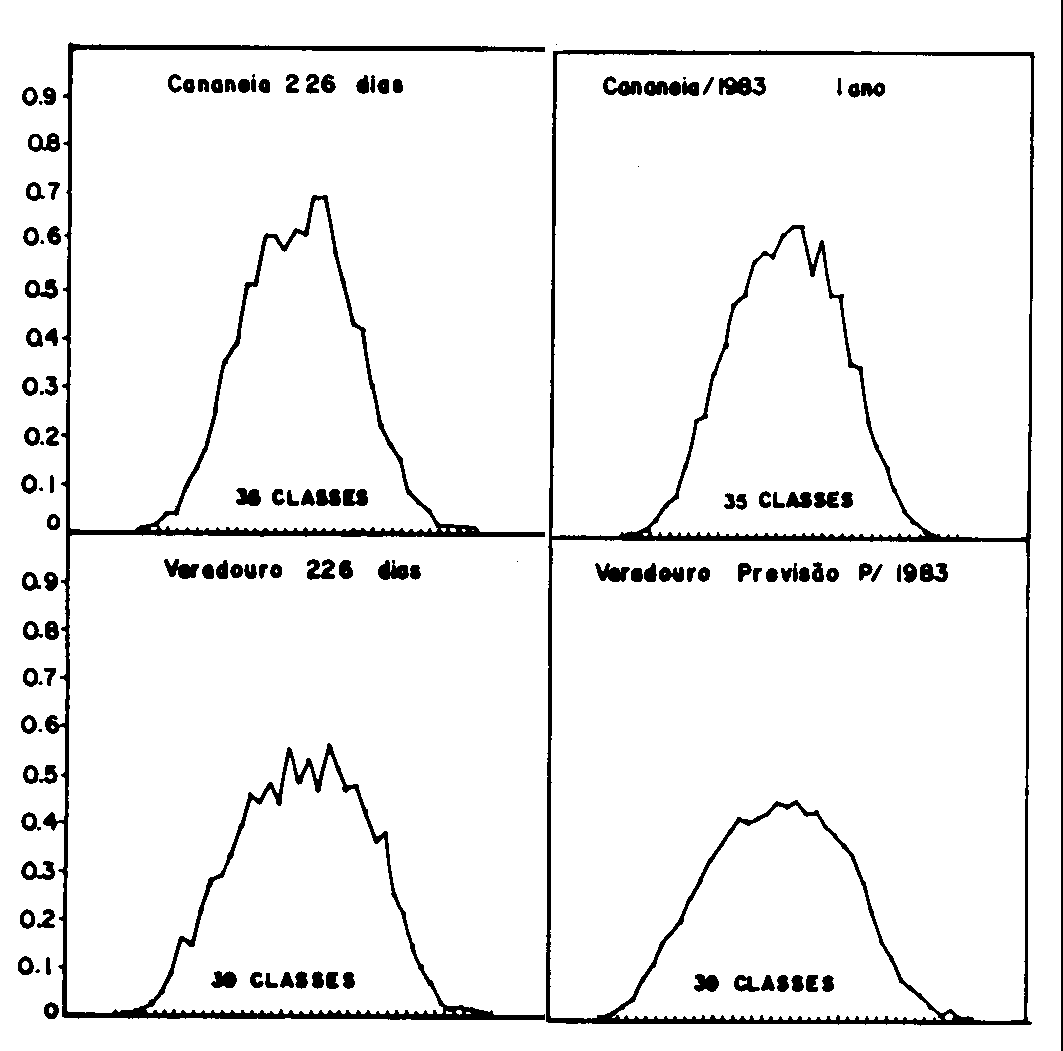
The method was certified by means of known simultaneous data from the permanent stations of Cananeia and Ubatuba places that are within a distance of about 300 Kilometres. The mean sea level was obtained with a maximum error for the mean monthly means of 7 cm and of the order of 1 cm for the long term mean sea level with an uncertainty of 10 cm for the estimates of the extreme values. (Mesquita & França,1991).
8 - ACKNOWLEDGEMENTS
Special thanks are due to FINEP (Funds for Studies and Projects of the Presidency of the Republic of Brasil) and FAPESP (Foundation for Research Aid of the State of São Paulo).
9 - REFERENCES
Aidar - Aragão, E . A., Teixeira C. & Vieira A H.
(1980). Produção primária e concentração
de clorofila a na costa brasileira ( Lat 22 31 ; Long 42 52 W). Bolm. Inst.
oceanogr. Univ. S. Paulo. S.P. 29 (2) : 9 - 14.
Belfrot Vieira, J. D. 1942. As Marés , Observação
Estudo e Previsão no Brasil. 169 paginas. Ver Biblioteca do Instituto
Oceanográfico da Universidade de São Paulo.
Cartwright, D. E. (1999). Tides- A Scientific History. Cambridge University
Press. Cambridge. UK.
Chao B F. "Concrete" Testimony to Milankovitch Cycle in Earth's Changing
Obliquity. EOS, Trans. Am. Gophys. Union. Vol ( 77 ) . Number 44. : 433
.
DHN (Diretoria de hidrografia e Navegação) .1996. Tábua
de Mares para 1997 .Min. mar. Rio de janeiro. Vol 34 : 1 - 196.
Emilson I . (1961). The Shelf and coastal waters off southern
Brazil. Bolm. Inst. oceanogr. , S Paulo. 11 ( 2 ) : 101 - 112.
Imbrie, E, J. Imbrie, N. (1980). Modeling climatic resposnse to orbital
variations. Science, 207:950-953.
França C A S .(1995). O litoral Brasileiro - Estudos sobre o
nível médio do mar. 1993. (Não publicado) Insti. oceanogr.
Univ. S Paulo. (ver Biblioteca do IOUSP). 21p.
França, A de S (2000). Contribuição ao Estudo
da Variabilidade do Nível do Mar na Região Tropical Atlântica
por Altimetria do Satélite TOPEX/POSEIDON e Modelagem Numérica.
Tese de Doutorado. Instituto Oceanográfico da Universidade de São
Paulo. 274p.
Franco, A S..(1968). The Munk - Cartwright method for prediciton of
discrete observations. I H. Review . 42 (I).
Franco, A S & Rock, N J . (1972). The fast Fourier transform
and its application to tidal oscillation. Bolm. Inst,. oceanogr. Univ.
S. Paulo. SP.
Franco, A S dos & Mesquita, A R de (1986).On
the Practical use in Hydrography of Filtered daily values of mean
sea level. Int. hidrg. Rev. Monaco. LXIII ( 2 ) : 133 - 141.
Furtado,V.V., Bonetti, J.Filho & Conti, L. A. (1996). Paleo
River morfology and sea level Changes as the southern Brazilian continental
Shelf. An. Acd. Bras. Ci., Vol 68. Supl. 1:163-170.
Johannessen, O M., Miranda, L B & Miniussi, I. B. (1967). Preliminary
study of seasonal sea level variation along the Southern part of Brazilian
coast. Contrções Inst. oceanogr. Univ. S. Paulo, ser. Oceanogr.
fis. (9) : 16 - 29.
Lemos, A. . (1928). Marés e Problemas Correlativos. Observatório
(Astronômico) Nacional do Riio de Janeiro. RJ. 92p
Magliocca A , Miranda L B de & Signorinni, S. R. (1979). Physical
and Chemical aspects of the transient stages of the upwelling at the southwest
of Cabo Frio (Lat 23 S ; Long 42 W). Bolm. Inst. oceanogr. Univ. S. Paulo.
Vol ( 28 ) , 2 : 37 - 46..
Martin, L., Suguio, K., Flexor, J. M. , Domingues, J M L., Bitencourt,
A C M S. (1987) . Quaternary evolution of the Central part of the Brazilian
coast. The role of the relative sea level variation and shore line drift.
In Unesco Quaternary Coastal geology of West Africa and South America.
UNESCO Reports in Marine Sciences n 43 : 97 - 145. Paris. France.
Mesquita A R de (1969) . Variações sazonais
nas Águas Costeira. Brasil Lat 23. Diss. Mestr. Inst. oceanogr.
Univ. S Paulo. SP. 78 p.
Mesquita A R de (1974) . Report on the seasonal variations of coastal
Waters; Brazil (Lat 24 3 S). Relat. int. Inst. oceanogr. Univ. S Paulo.
SP. (1) : 1 - 36.
Mesquita A R de & Harari J (1977). Variações
sazonais em águas costeira: Brasil Lat 24 . Parte II. Bolm Inst.
oceanogr. S Paulo, 26 : 339 - 365, 1977.
Mesquita A R de & Harari J (1983). Tides and Tide Gauges of Cananéia
and Ubatuba. Relat. int. Inst. oceanogr. Univ. S. Paulo. SP. (11) : 1 -
14.
Mesquita A R de & Leite J B A (1986). Sobre a Variabilidade do
Nível Médio do Mar na costa Sudeste do Brasil. Rev. bras.
de Geofis. Vol ( 4 ) : 229 - 236.
Mesquita A R de. Franco A S & Harari J. (1986). On
mean sea level variation along the Brazilian coast I. Gephys. J. R astr.
SOC. London Vol ( 87 ( 1 ) : 67 - 77.
Mesquita A R de & França C A S (1989). Tidal Statistics
of Varadouro Channel as Inferred from Cananéia tidal Station. Academia
de Ciencias do Estado de São Paulo. S Paulo. vol ( 2 ) : 242 - 254.
Mesquita A R de & França C A S (1991). On the transference
method for the mean and extreme sea level values. Acad. ci. Est. S Paulo.
S Paulo. SP. Vol ( 1 ) : 55 - 64.
Mesquita A R de (1994) .Variação do nível
do mar de longo termo. Inst. est. Avanç. Univ. S Paulo. SP. Documentos
- Série Ciências Ambientais. Vol ( 20 ) : 47 - 67.
Mesquita A R de , Harari J & França C A S (1995) Interannual
variability of tides and sea level at Cananéia , Brazil, from 1955
to 1990. Publcão esp. Inst. oceanogr. Univ. s Paulo. SP. (11)
: 11 - 20.
Mesquita A R de , Harari J & França C A S (1996). Global
Change in the South Atlantic: Decadal and Intradecadal Scales. An. Acad.
bras. Ci., Vol( 68 ) . Supl.1 : 117 - 128.
Mesquita, A R de (1998). O programa IOUSP para o Global Changes : Origem
e Contribuições. Apresentado no Seminário Ciência
e Desenvolvimento Sustentável. Inst. est. Avaç.
Univ. S. Paulo. SP. Volume único : 130-146.
Miniussi, I. C. 1958. Nível médio , nível de redução
das sondagens e a variação anual do nível médio
mensal do porto de Cananéia. Contrçõs Inst .oceanogr.
, Univ. S Paulo, ser. Oceanogr. fis., (2) : 1 - 7.
Miranda, L B de (1970). Flutuações da Corrente do Brasil
e variações da distribuição horizontal da temperatura
na região costeira entre Cabo de São Tomé e Ilha de
São Sebastião em Janeiro e Fevereiro e Abril de 1970. caderno
de Ciencias da Terra, São Paulo, 3, parte 2 : 13 - 14.
Morettin, P A, Toloy, C M, Gait, N & Mesquita A R de.
(1993). Analysis of the Relationships between some natural phenomena: Atmospheric
precipitation , mean sea level and sunspots. Rev. bras. Metorolol. 8 (1
) : 11 - 21.
Silva, P M C da (1968). O fenômeno ressurgência na
costa meridional brasileira. Publições Inst. pesq. Mar. Vol
( 24 ) : 1 - 31.
Teixeira C. (1973). Preliminary studies of primary production
in the Ubatuba region ( Lat 23 30 S ; Long 45 06 W), Brazil. Bolm.
Inst. oceanogr. Univ. S.,Paulo SP. 22 : 40 - 58.